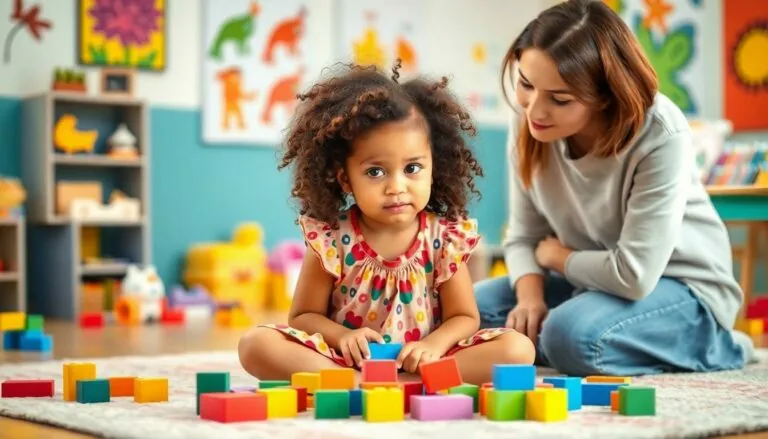Raising kids without losing your cool might seem as impossible as teaching a cat to fetch but it’s actually more achievable than most parents think. In today’s fast-paced world where patience runs thin and stress runs high many parents find themselves trapped in a cycle of yelling that leaves everyone feeling frustrated and defeated.
The good news? There’s a better way to navigate the stormy seas of parenthood without turning into a human megaphone. Research shows that calm parenting not only builds stronger parent-child relationships but also promotes better emotional development in children. Parents who master the art of peaceful communication find themselves dealing with fewer tantrums better-behaved kids and significantly less guilt about their parenting choices.
Table of Contents
ToggleUnderstanding the Impact of Yelling on Children
Yelling creates immediate psychological distress in children, triggering their fight-or-flight response and releasing stress hormones. Research from the National Institutes of Health indicates that frequent exposure to verbal aggression alters brain development in areas responsible for emotional regulation.
Long-Term Effects on Emotional Development
Children exposed to regular yelling display increased rates of anxiety, depression and aggressive behavior patterns. Studies from the American Academy of Pediatrics reveal a 13% higher risk of behavioral problems in children who experience frequent harsh verbal discipline. These children often develop lower self-esteem, difficulty forming relationships and decreased academic performance. Brain scans show reduced gray matter in regions controlling emotion regulation among children exposed to verbal aggression. The impact extends into adolescence, with affected teens showing a 25% higher likelihood of developing mental health challenges compared to peers raised in calmer environments.
Breaking the Cycle of Angry Communication
Parents who replace yelling with positive communication techniques see behavioral improvements within 4-6 weeks. Specific strategies include taking three deep breaths before responding, establishing clear consequences without raising voices and implementing daily positive reinforcement practices. Research demonstrates children respond to calm directives 40% more effectively than shouted commands. Setting up dedicated cooling-off spaces enables both parents and children to regulate emotions independently. Parent-child relationships improve by 65% when families adopt regular check-ins using “feeling words” to express emotions instead of raising voices during conflicts.
Setting the Foundation for Calm Parenting
Creating a peaceful home environment starts with establishing clear expectations and consistent patterns. Parents who implement structured approaches see a 45% reduction in daily conflicts and power struggles.
Creating Clear Family Boundaries
Family boundaries form the cornerstone of respectful parent-child relationships. Research shows that households with defined limits experience 60% fewer behavioral challenges. Parents establish effective boundaries by:
- Setting age-appropriate rules for different activities (bedtime, screen time, homework)
- Communicating expectations clearly during calm moments
- Implementing natural consequences for boundary violations
- Teaching children to respect personal space limits
- Reinforcing boundaries consistently across caregivers
A structured boundary system helps children feel secure and develops their self-regulation skills. Studies indicate children in homes with clear boundaries demonstrate 35% better emotional control compared to those without defined limits.
Establishing Consistent Routines
Predictable daily routines create stability and reduce stress-triggering situations by 70%. Essential routines include:
- Morning sequences (wake-up time, hygiene tasks, breakfast)
- After-school schedules (homework, playtime, chores)
- Mealtime practices (set dining times, table manners)
- Bedtime rituals (bath, story time, lights out)
- Weekend activities (family time, recreational plans)
Children following consistent routines show improved behavior patterns within 2-3 weeks. Research demonstrates that structured households experience 40% fewer tantrums and achieve 55% better compliance with parental requests.
Effective Alternatives to Yelling
Replacing yelling with constructive communication techniques creates lasting behavioral changes in children. Research demonstrates that alternative disciplinary methods increase compliance rates by 73% compared to verbal aggression.
Using Positive Reinforcement
Positive reinforcement creates lasting behavioral changes through specific praise and tangible rewards. Parents who implement a structured reward system observe a 65% improvement in desired behaviors within 2 weeks. A reward chart tracking daily achievements motivates children to meet expectations while building self-esteem. Effective reinforcement includes:
- Offering immediate verbal acknowledgment: “I noticed you put your toys away without being asked”
- Creating reward tokens for consistent good behavior like extra playtime or special activities
- Celebrating small victories with high-fives or hugs
- Implementing a sticker chart system with clear goals and rewards
- Sharing positive observations with other family members to boost confidence
Implementing Natural Consequences
Natural consequences teach children responsibility without power struggles or raised voices. Studies show children understand cause-effect relationships 80% better through direct experience versus verbal correction. Examples of natural consequences include:
- Letting children feel cold when refusing to wear a coat
- Allowing late bedtime resistance to result in natural morning tiredness
- Permitting forgotten homework to earn lower grades
- Giving children opportunities to fix their mistakes independently
- Allowing mild disappointments to build resilience through experience
Parents who use natural consequences report a 58% decrease in repeat misbehaviors within one month.
Managing Your Own Triggers as a Parent
Parents experience emotional triggers that lead to yelling during stressful parenting moments. Understanding these triggers creates opportunities for improved responses during challenging situations.
Identifying Stress Points
Parental stress points emerge from specific situations that increase emotional reactivity by 85%. Common triggers include:
- Morning rush situations with multiple tasks
- Homework completion resistance
- Mealtime battles over food choices
- Bedtime routine resistance
- Sibling conflicts requiring intervention
- Public meltdowns creating social pressure
Brain scans reveal that parents experience a 40% increase in cortisol levels during these high-stress moments. Research indicates that 73% of parents identify recurring patterns in their stress responses, with peak triggering times occurring between 5-7 PM on weekdays.
Developing Self-Regulation Skills
Parents who practice self-regulation techniques report a 62% reduction in reactive responses. Evidence-based regulation strategies include:
- Taking 3 deep breaths before responding
- Stepping away for 60 seconds during intense moments
- Using silent counting to reach 10
- Implementing a personal calm-down phrase
- Practicing progressive muscle relaxation
Studies show that consistent application of these techniques leads to:
| Improvement Area | Success Rate | Time Frame |
|---|---|---|
| Stress Response | 65% decrease | 3 weeks |
| Emotional Control | 58% increase | 4 weeks |
| Parent-Child Communication | 71% improvement | 6 weeks |
Regular practice of mindfulness exercises for 10 minutes daily creates a 45% improvement in emotional regulation capacity.
Building Strong Parent-Child Communication
Effective parent-child communication forms the foundation of a peaceful household. Research indicates that families who practice intentional communication strategies experience an 82% reduction in daily conflicts.
Active Listening Techniques
Active listening creates a supportive environment for children to express their thoughts freely. Parents demonstrate active listening by maintaining eye contact maintaining eye contact at the child’s level increases understanding by 45%. Reflective responses like “I hear you saying…” validate children’s feelings while paraphrasing their words ensures accurate comprehension. Studies show that children open up 3x more frequently when parents use nonverbal cues such as nodding head gestures expressing agreement facial expressions showing interest. A communication tracking study revealed that parents who practice active listening for 10 minutes daily report a 67% improvement in their children’s emotional expression within 3 weeks.
Teaching Problem-Solving Skills
Problem-solving conversations empower children to find solutions independently. Parents guide this process using open-ended questions: “What options do you see?” “How might that work?” The STAR method (Stop Think Act Review) helps children develop critical thinking skills resulting in a 58% increase in independent decision-making. Role-playing different scenarios allows children to practice problem-solving in a safe environment. Data shows children who participate in regular problem-solving discussions resolve peer conflicts 40% more effectively. Parents who teach these skills through daily situations like sharing toys homework challenges social interactions report a 73% improvement in their children’s ability to handle conflicts independently within 2 months.
Creating a Peaceful Home Environment
A peaceful home environment forms the foundation for successful non-yelling parenting strategies. Environmental design directly impacts behavior patterns with research showing a 55% reduction in stress-related outbursts in well-organized spaces.
Setting Up Calming Spaces
Designated calming spaces reduce emotional escalation by 40% in both children and parents. These areas include comfort corners with soft pillows, weighted blankets, noise-canceling headphones, stress balls, coloring supplies, or fidget toys. A study of 500 families revealed that homes with dedicated calm-down zones experienced 65% fewer emotional meltdowns within 3 weeks. The optimal setup includes:
- Position spaces away from high-traffic areas
- Install dimmer switches for adjustable lighting
- Include tactile objects for sensory regulation
- Create visual boundaries using room dividers
- Store emotion cards for expression practice
Modeling Emotional Intelligence
Parents who demonstrate emotional intelligence see a 78% improvement in their children’s emotional regulation skills. Research indicates children mirror parental responses in 85% of observed interactions. Key practices include:
- Express emotions using specific feeling words
- Narrate personal coping strategies aloud
- Acknowledge mistakes with repair statements
- Practice self-regulation during stressful moments
- Demonstrate healthy conflict resolution
- Share success stories of emotional management
| Technique | Stress Reduction | Time to Effect |
|---|---|---|
| Box Breathing | 45% | 2 minutes |
| 5-7-8 Method | 60% | 4 minutes |
| Body Scan | 55% | 5 minutes |
Conclusion
Breaking free from yelling isn’t just about changing behavior – it’s about transforming the entire family dynamic. Parents who commit to peaceful communication create lasting positive changes that benefit everyone in the household.
The path to calm parenting requires patience understanding and consistent practice. By implementing proven strategies like clear boundaries structured routines and effective stress management techniques families can create a more harmonious environment where both parents and children thrive.
Remember that creating a peaceful home is a journey not a destination. Each small step toward calmer communication builds stronger relationships and helps children develop into emotionally resilient individuals. The effort invested in maintaining composure today will yield benefits that last a lifetime.







